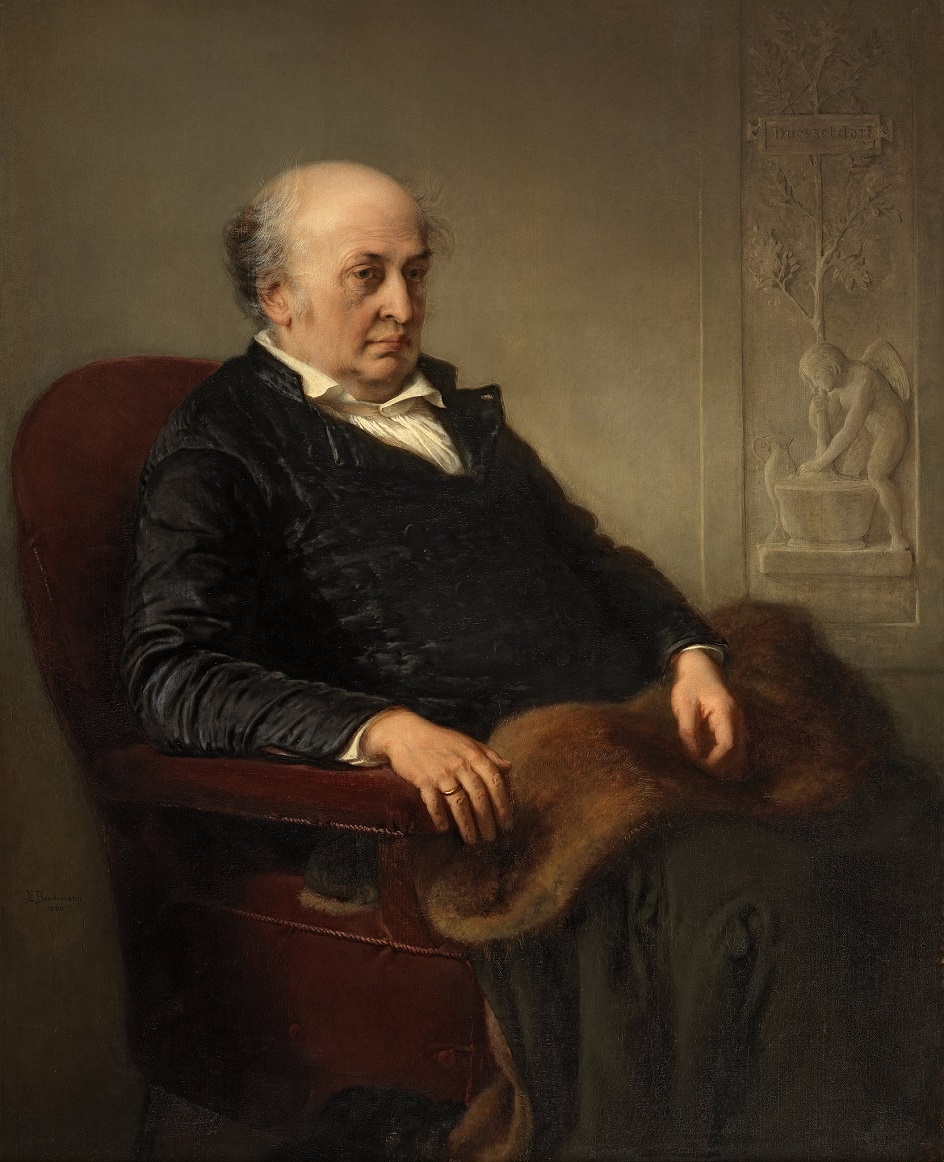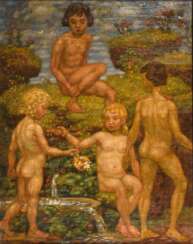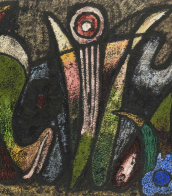wilhelm von diez

Albrecht Christoph Wilhelm von Diez was a German painter of the second half of the 19th and early 20th centuries. He is known as a painter and illustrator, a representative of the Munich school.
Wilhelm von Diez became known for his illustrations for the satirical magazine Fliegende Blätter and his work on illustrations for Schiller's History of the Thirty Years' War. His drawings were characterized by light brushstrokes in the manner of etchings and a clear treatment of shadow. Later he was engaged in animalistic, landscape and genre painting. In 1871 von Diez became a lecturer at the Munich Academy of Fine Arts and in this position he had a great influence on the development of his pupils and on the Munich school of painting in general.


Albrecht Christoph Wilhelm von Diez was a German painter of the second half of the 19th and early 20th centuries. He is known as a painter and illustrator, a representative of the Munich school.
Wilhelm von Diez became known for his illustrations for the satirical magazine Fliegende Blätter and his work on illustrations for Schiller's History of the Thirty Years' War. His drawings were characterized by light brushstrokes in the manner of etchings and a clear treatment of shadow. Later he was engaged in animalistic, landscape and genre painting. In 1871 von Diez became a lecturer at the Munich Academy of Fine Arts and in this position he had a great influence on the development of his pupils and on the Munich school of painting in general.


Albrecht Christoph Wilhelm von Diez was a German painter of the second half of the 19th and early 20th centuries. He is known as a painter and illustrator, a representative of the Munich school.
Wilhelm von Diez became known for his illustrations for the satirical magazine Fliegende Blätter and his work on illustrations for Schiller's History of the Thirty Years' War. His drawings were characterized by light brushstrokes in the manner of etchings and a clear treatment of shadow. Later he was engaged in animalistic, landscape and genre painting. In 1871 von Diez became a lecturer at the Munich Academy of Fine Arts and in this position he had a great influence on the development of his pupils and on the Munich school of painting in general.


Albrecht Christoph Wilhelm von Diez was a German painter of the second half of the 19th and early 20th centuries. He is known as a painter and illustrator, a representative of the Munich school.
Wilhelm von Diez became known for his illustrations for the satirical magazine Fliegende Blätter and his work on illustrations for Schiller's History of the Thirty Years' War. His drawings were characterized by light brushstrokes in the manner of etchings and a clear treatment of shadow. Later he was engaged in animalistic, landscape and genre painting. In 1871 von Diez became a lecturer at the Munich Academy of Fine Arts and in this position he had a great influence on the development of his pupils and on the Munich school of painting in general.


Albrecht Christoph Wilhelm von Diez was a German painter of the second half of the 19th and early 20th centuries. He is known as a painter and illustrator, a representative of the Munich school.
Wilhelm von Diez became known for his illustrations for the satirical magazine Fliegende Blätter and his work on illustrations for Schiller's History of the Thirty Years' War. His drawings were characterized by light brushstrokes in the manner of etchings and a clear treatment of shadow. Later he was engaged in animalistic, landscape and genre painting. In 1871 von Diez became a lecturer at the Munich Academy of Fine Arts and in this position he had a great influence on the development of his pupils and on the Munich school of painting in general.


Wilhelm von Kobell was a German painter of the first half of the 19th century. He is known as a landscape painter, animalist and battle painter.
Von Kobell initially produced landscapes and animal paintings, but later focused mainly on battle painting. He visited Vienna and Paris between 1809 and 1810 to study this genre. His battle paintings, based on extensive research, are characterized by striking realism. They are important for the study of military history.


Wilhelm von Kobell was a German painter of the first half of the 19th century. He is known as a landscape painter, animalist and battle painter.
Von Kobell initially produced landscapes and animal paintings, but later focused mainly on battle painting. He visited Vienna and Paris between 1809 and 1810 to study this genre. His battle paintings, based on extensive research, are characterized by striking realism. They are important for the study of military history.


Wilhelm von Kobell was a German painter of the first half of the 19th century. He is known as a landscape painter, animalist and battle painter.
Von Kobell initially produced landscapes and animal paintings, but later focused mainly on battle painting. He visited Vienna and Paris between 1809 and 1810 to study this genre. His battle paintings, based on extensive research, are characterized by striking realism. They are important for the study of military history.


Friedrich Wilhelm von Schadow was a prominent German Romantic painter whose influence extended far beyond his own creations. He is perhaps best known for his role in forming the Düsseldorf School, a hub that nurtured talents from around the world, including notable American painters. This school under Schadow's guidance became a beacon of artistic excellence, producing renowned artists like Emmanuel Leutze.
Friedrich Wilhelm von Schadow's approach to art was not just about creating visually appealing works; it was deeply rooted in imparting knowledge and nurturing creativity among his students, leaving a lasting impact on the art world. His own works, though less celebrated than his educational contributions, still hold significance in the realm of German Romantic art, reflecting the era's spirit and depth.
For those interested in the intersection of art, culture, and history, Friedrich Wilhelm von Schadow's legacy offers a rich vein to explore. His role in shaping the Düsseldorf School and his artistic philosophy provide invaluable insights into the 19th-century art movement.
If you're fascinated by Friedrich Wilhelm von Schadow's contributions to art and wish to stay informed about related updates, consider signing up for newsletters or alerts that focus on art history, particularly related to the Düsseldorf School and German Romanticism. This way, you'll be in the loop about new discoveries, exhibitions, and sales pertaining to Friedrich Wilhelm von Schadow's works and his profound influence on the art world.


Wilhelm von Lindenschmit the Younger was a German painter of the second half of the nineteenth century. He is known as a historical painter, professor at the Munich Academy of Fine Arts, and son of the painter Wilhelm von Lindenschmit Sr.
Lindenschmitt the Younger created a number of historical paintings in Frankfurt am Main early in his career in 1853 after studying in France, including The Captivity of King Francis I, The Death of Franz von Zickingen, and The Assembly and Reformation in Marburg. In 1863 he moved to Munich, where he also painted numerous paintings including The Fisherman and the Mermaid, Young Luther at Andreas Proles, and The Death of William of Orange. He also produced frescoes and large-scale paintings, including Alaric's Entry into Rome.


Albrecht Christoph Wilhelm von Diez was a German painter of the second half of the 19th and early 20th centuries. He is known as a painter and illustrator, a representative of the Munich school.
Wilhelm von Diez became known for his illustrations for the satirical magazine Fliegende Blätter and his work on illustrations for Schiller's History of the Thirty Years' War. His drawings were characterized by light brushstrokes in the manner of etchings and a clear treatment of shadow. Later he was engaged in animalistic, landscape and genre painting. In 1871 von Diez became a lecturer at the Munich Academy of Fine Arts and in this position he had a great influence on the development of his pupils and on the Munich school of painting in general.


Friedrich August von Kaulbach was a German portraitist and historical painter.







































































